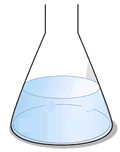|
Experimental data can provide information regarding the relative quantities reacting in the stoichiometric equation. Similar data could also be used to produce balanced equations for a reaction proceeding once molar quantities are obtained. Such data may include: |
|
Mass Data
This may be obtained directly by weighing, or may be inferred by subtraction in, for example, the loss of a gas from the reaction mixture.
Mass data is recorded using a balance. The balance may or may not be electronic having a degree of accuracy that depends on the instrument in question. The tolerance or degree of accuracy of the balance is usually taken to be ±5 of one decimal place beyond the last digit. i.e. a balance that weighs in grams to 2 decimal places has a tolerance (degree of accuracy) of ±0.005g
|
Example: In the reaction between calcium carbonate and excess hydrochloric acid on a top pan balance the reading on the balance went from 157.30g to 155.36g in the course of the reaction (all of the calcium carbonate dissolved). A consideration of the reaction taking place: CaCO3 + 2HCl shows that carbon dioxide is released in the course of the reaction, and that the moles of carbon dioxide is equivalent to the moles of calcium carbonate present at the start of the reaction. Mass change during the reaction = 157.30g - 155.36g = 1.94g This is the carbon dioxide released (Mr of CO2= 44) Moles of carbon dioxide = 1.94/44 = 0.044 moles Therefore there were 0.044 moles of calcium carbonate at the beginning = 0.044 x 100 = 4.4g |
Gas volume
In the above example it would be just as feasible to measure the volume of the carbon dioxide released and from this to obtain the number of moles of carbon dioxide.
|
|
|
Gas volumes may be measured using a gas syringe, or by collection over water or another suitable liquid. The units normally employed at IB level are cm3 and dm3 (litres), where 1 dm3 = 1000cm3. The choice of technique usually comes down to convenience and accuracy. Gas syringes are very simple to use, but may develop leaks, or stick during operation. |
The volume of any gas at RTP (room temperature and pressure) is approximately 24 litres per mole, measured at STP it is 22.7 litres per mole. For more accurate calculations the ideal gas law PV = nRT may be applied where:
- P is the atmospheric pressure
- V is the gas volume
- R is the universal gas constant
- T is the temperature in Kelvin
- n is the number of moles
Gay Lussac's law of combining gas volumes
Gas volumes may also be dealt with as being proportional to the number of moles present, as all gases have the same characteristics in terms of volume, temperature and pressure for equal numbers of moles.
Hence a reaction:
C4H8(g) + 6O2(g)![]() 4CO2(g) + 4H2O(g)
4CO2(g) + 4H2O(g)
May be stated as, 1 mole of butene reacting with 6 moles of oxygen to produce 4 moles of carbon dioxide plus 4 moles of steam, OR 1 volume of butene reacting with 6 volumes of oxygen to produce 4 volumes of carbon dioxide plus 4 volumes of steam.
This allows easy calculation of the volume of gases involved in a chemical reaction.
|
Example: In the following reaction: C4H8(g) + 6O2(g)
200cm3 of butene were used. How much oxygen would be needed for complete reaction and what volume of products would be made? (all gases measured under the same conditions of Temperature and Pressure) Volume gas ratio = 1 : 6 200cm3 of butene would therefore require 6 x 200cm3 = 1200cm3 of oxygen and would produce 4 x 200cm3 = 800cm3 of carbon dioxide and an equal volume of steam. |
NOTE: IB students do not specifically need to know the statement of this principle, just to be able to use it.
Solutions data
The concentration of a solute is measured in moles of solute per litre. If the volume of the solution is known, then the number of moles contained by the solution can be calculated.
moles = molarity x volume
For example a 2.0M solution contains 2 moles of solute per litre (1 litre = 1000cm3)
100cm3 of a 2.0M solution contains 100/1000 x 2 moles = 0.2 moles of solute
The concentration of solutions is often determined by titration
|
Example: 2.5g of impure calcium carbonate was added to 50cm3 of 2M HCl solution. Analysis of the resultant solution revealed that the new molarity of the HCl was 1.85M. Calculate the percentage purity of the calcium carbonate sample. Total moles of hydrochloric acid before reaction = 0.05 x 2 = 0.1 moles Total moles of hydrochloric acid after reaction = 0.05 x 1.8 = 0.09 moles Therefore moles of acid reacted = 0.1 - 0.09 = 0.01 moles Equation for the reaction: CaCO3 + 2HCl 1 mole of calcium carbonate reacts with 2 moles of acid Therefore 0.005 moles of carbonate reacted with 0.01 moles of acid Mr of CaCO3 = 100 therefore 0.005 moles = 0.005 x 100g = 0.5g But the original sample had a mass of 2.5g of which only 0.5g was calcium carbonate Percentage purity of the sample = 0.5/2.5 x 100 = 20% |


